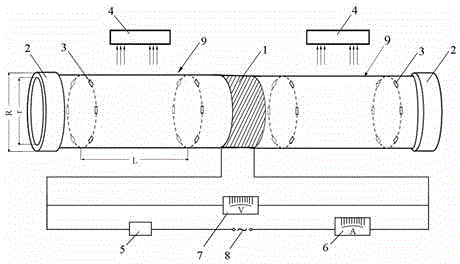Device for testing axial thermal conductivity of tubular materials
A thermal conductivity and tubular technology, which is applied in the field of devices for testing the axial thermal conductivity of tubular materials, can solve the problem of no axial thermal conductivity of tubular materials, and achieve the effect of avoiding heat loss
- Summary
- Abstract
- Description
- Claims
- Application Information
AI Technical Summary
Problems solved by technology
Method used
Image
Examples
Embodiment Construction
[0023] A device for testing the axial thermal conductivity of tubular materials of the present invention will be described in detail below in conjunction with the accompanying drawings and specific examples:
[0024] like figure 1 As shown, a device for testing the axial thermal conductivity of tubular materials includes an annular heater 1 arranged between the end faces of two tubular materials to be tested 9 that are identical in material and appearance size, and the tubular materials to be tested 9 are far away from One end of the ring heater 1 is provided with a cooling ring 2; the ring heater 1 is an annular sheet, and the inner diameter and the outer diameter of the ring heater 1 are the same as the inner diameter and the outer diameter of the tubular material 9 to be tested; No less than three temperature-measuring elements 3 are pasted on the outer walls of both ends of the tubular material 9, and the temperature-measuring elements 3 at each end are evenly distributed ...
PUM
| Property | Measurement | Unit |
|---|---|---|
| thickness | aaaaa | aaaaa |
Abstract
Description
Claims
Application Information
 Login to View More
Login to View More - R&D
- Intellectual Property
- Life Sciences
- Materials
- Tech Scout
- Unparalleled Data Quality
- Higher Quality Content
- 60% Fewer Hallucinations
Browse by: Latest US Patents, China's latest patents, Technical Efficacy Thesaurus, Application Domain, Technology Topic, Popular Technical Reports.
© 2025 PatSnap. All rights reserved.Legal|Privacy policy|Modern Slavery Act Transparency Statement|Sitemap|About US| Contact US: help@patsnap.com


